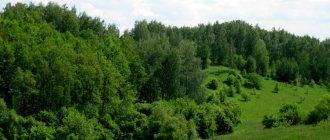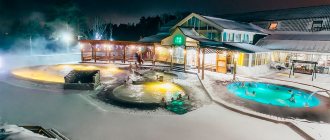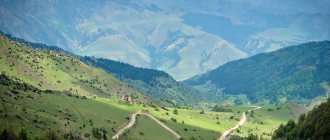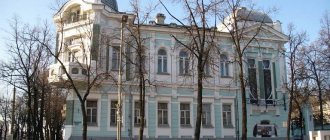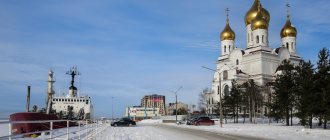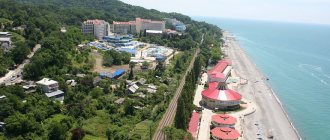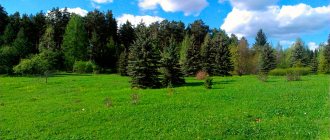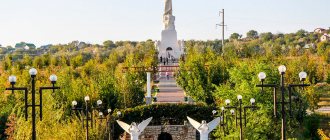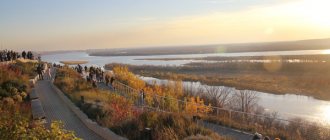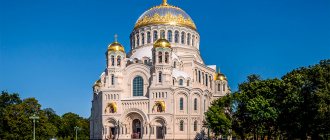Tver
The regional center boasts a large number of attractions: from the travel palace, built for Catherine II and now an art gallery, to the Starovolzhsky Bridge, the city garden, the Nativity Cathedral and the St. Catherine's Convent.
There are also unusual museums in Tver, for example, the Goat Museum and the Plyushkin Museum. And in the city there is one of the places of pilgrimage for chanson lovers - a monument to the cult performer Mikhail Krug. Next to him there are almost always people who want to sit on the bench and take a photo.
Photo: https://ru.m.wikipedia.org
Mineral and holy springs of the area
The Tver region is rich in springs; each district boasts the presence of a dozen clean springs. Many of them are associated with stories of healing from serious illnesses and other miracles.
Kashinsky mineral springs
- Coordinates: 57.363200, 37.601390.
The mineral waters of the city of Kashin are known throughout the country. The Three Springs have long been a place of pilgrimage for believers. Orthodox Christians came to the city to venerate Saint Anna of Kashin, and at the same time collected water from holy springs.
At the beginning of the 19th century, local doctor D. Chernyavsky investigated the healing properties of mineral water and contributed to the creation of the Kashin balneological resort. The springs were soon abandoned, but in 1883 the area found a second life and became a popular resort.
At the beginning of the 19th century, next to the well-equipped sanatorium, a mud bath was erected, in which peat mud treatment was carried out. Some experts noted that Kashinskaya mineral water is richer than Zheleznovodskaya.
During the Soviet years, springs were also used to treat and prevent many diseases. In addition to already known sources, several new wells have appeared. Nowadays, mineral water is used not only in the local sanatorium, but is also bottled and sold in almost all regions of the country.
Mshenskie springs
- Address: s. Mshentsy, Bologovsky district.
Nature has given the ancient village of Mshentsy many cold and clean springs, among which the two largest stand out: the Vmch spring. Paraskeva Fridays and the source of the Kazan Icon of the Mother of God. The first was named after the temple of the same name, the only building that survived from the destroyed monastery. In the second, according to legend, in 1812 the miraculous image of the Blessed Virgin Mary appeared.
At the beginning of 1916, the archaeologist and writer N. Roerich described the springs in his essay “The Undrinking Cup.” Years later, local historian L. Bricker immortalized an excerpt from the work on a tablet, which he later hung on a large stone boulder near the springs. Today the springs are recognized as a natural monument; a wooden chapel rises above one of them.
Red key
- Address: village Kholokholnya.
An unusual source is hidden among the forests in the vicinity of the village of Kholokholnya. The waters of the spring are known for their high iron content, due to which the ground through which the spring flows turns red-brown, as if covered with rust. A stormy stream runs briskly along a steep slope, forms a picturesque waterfall and flows into the Kholokholnya River.
Yeletsky spring
- Address: pos. Elets.
The spring near the city of Yeltsy was named “Zdorovets” and was consecrated in honor of St. Paraskeva Fridays. The first mention of the holy spring dates back to the end of the 15th century. Currently, a high chapel has been erected above the spring, inside of which there is a font for immersion. Outside you can get water from a special tap. The holy spring belongs to the territory of the Zhitenny Monastery.
Maslovskie springs
- Address: village Maslovo.
The springs near the village of Maslovo are popularly called “the springs of living and dead water.” One of the springs was consecrated in honor of St. John the Baptist, with fonts and a small church built above it. The second spring is nicknamed “eye”, as its waters can heal eye diseases.
The water temperature in the two springs does not rise above 4°C all year round. The springs are saturated with minerals and truly have healing properties; many pilgrims claim that they can see better simply by washing their faces with cold water.
Okovetsky key
- Coordinates: village Okovtsy.
A clean, cold spring gushes out of the ground near the village of Okovtsy like a stormy stream and runs down the drain into the nearest river. In Okovtsy, the legend about the origin of the holy spring is passed down from generation to generation.
In 1539, two thieves were hiding in the Okovets forest and suddenly saw an icon of the Holy Cross above a spring. A monk of the Selizharov Monastery named John came to the place of the miraculous phenomenon. Arriving in the village, the monk discovered an icon of the Mother of God with the Child Christ.
Pilgrims flocked to the icons and the spring, many believers were healed of illnesses. Metropolitan Joasaph ordered the construction of two churches nearby: in honor of the Hodegetria icon of the Mother of God and in honor of the Origin of the Honest Trees. During the Soviet years, the icons disappeared without a trace, and the source was desecrated.
After the collapse of the USSR, a new church was erected on the site of the destroyed churches and comfortable wooden baths were installed for immersion in holy water. Every year at the end of July, after the festive liturgy, believers go in procession from the temple to the source.
Torzhok
There are a lot of beautiful churches in this ancient city, for example, the Church of the Entry of the Lord into Jerusalem, the Transfiguration Cathedral, the Church of St. George, etc. In addition, the Boris and Gleb Monastery Complex looks impressive, and lovers of wooden architecture should definitely see the Old Ascension Church.
Torzhok is also famous throughout Russia for gold seamstresses: there is a museum dedicated to them, where you can take part in a master class, and a shop with excellent souvenirs. The city also has its own culinary symbol: Pozharsky chicken cutlets in bread crumbs. They were immortalized by Alexander Sergeevich Pushkin himself in a poetic letter to Sobolevsky. Now Pozharsky cutlets are served in many cafes in Torzhok.
Souvenirs
What can you bring from a trip to the Tver region? What souvenirs are in particular demand among tourists?
Kalyazinskaya bell tower
Travelers extremely value Tver flax. Products made from durable fabric are practical, beautiful and durable.
A large selection of linen souvenirs - sheets, towels, tablecloths, aprons, oven mitts, curtains, pillowcases and summer clothes can be easily found in the Tverskoy Len store, which is located at number 21 on Ordzhonikidze Street in Tver.
Tourists love the gold embroidery from Torzhok. Shops and souvenir shops sell dresses, scarves, gloves, ties, handbags, paintings and curtains, royally decorated by gold seamstresses. Previously, real gold thread was used to decorate fabric, but now thin gilded wire is used. Beautiful handmade items are expensive, so many people limit themselves to small items with embroidered floral miniatures. The most common souvenirs are phone cases, brooches, document covers, key holders and cosmetic bags.
Source of the Volga
Connoisseurs of beautiful and high-quality tableware bring back the famous Konakovo porcelain from a trip to the Tver lands.
Bright painted products decorate any home and become a wonderful gift for friends.
More than half of the region's territory is covered with forests, so in the Tver lands there are many experienced woodcarvers and craftsmen who work with birch bark and wicker. Nice souvenirs are sold everywhere. Tourists willingly take small crafts, wooden dishes, kitchen utensils, boxes and baskets made of birch bark.
If you want to take home delicious souvenirs, pay attention to Afanasy beer, which is sold in supermarkets and specialized beer stores.
The region produces different types of beer, from light to dark.
Tver Imperial Travel Palace
In the small town of Kashin they produce a good balm “Old Kashin”. It is made from 24 berries and herbs, so the drink is aromatic, tasty and has healing properties. Among lovers of strong alcohol, the “Old Herbalist” balm and the “Heather Honey” liqueur are popular.
| ← RUSSIA | EUROPE → |
Kalyazin
The bell tower of St. Nicholas Cathedral, surrounded by water, is the main symbol of this small city. It reminds of a sad event in its history: during the construction of the Uglich hydroelectric power station, a significant part of the territory of Kalyazin, where many architectural monuments were located, was simply flooded.
The city has a family tourism facility - Baba Yaga's Estate, where Kikimora Bolotnaya also lives with her. And gourmets can be recommended to visit the snail farm with a tasting room, which was opened on the territory of the local yacht club.
Zavidovo (national park)
Zavidovo National Park in the Tver Region is a federally protected area founded in 1972. Its area is 125 thousand hectares, of which 80 thousand are forests and about 17 thousand hectares are meadows. The forests of Zavidovo are a mixture of coniferous and deciduous species, a rich fauna - up to 41 species of mammals, forest and waterfowl, and many species of fish. The state residence of the President of the Russian Federation “Rus” is located on the territory of the park.
According to UNESCO, Zavidovo National Park in the Tver region is one of the most beautiful and environmentally friendly places on Earth. In the 16th century here stood the hunting hut of Ivan IV the Terrible, and in the 1920s Lenin loved to come hunting. Since the early 1960s, a demonstration hunting area with a developed infrastructure for receiving high-ranking government guests has been created in these places. Since 1971, a state scientific and experimental reserve was created on the basis of the hunting reserve of the USSR Ministry of Defense.
Toropets
Toropets, located 263 kilometers west of Tver, was founded back in 1074. Here you should definitely see the city ramparts and ancient churches, for example, the Korsun-Bogoroditsky Cathedral. And it was in Toropets that the first monument to a teacher in our country was built. It is very popular among schoolchildren. There is a sign that whoever strokes the foot of the monument will have success in his studies.
Photo: https://commons.wikimedia.org/
oxbow
The iconic landmark of the city is the Holy Dormition Monastery, located on the banks of the Volga. In addition, you should definitely see the 16th-century Vvedenskaya Church and ancient forges here. And it’s just very pleasant to walk around Staritsa, admiring its fantastically beautiful landscapes.
Photo: https://ru.m.wikipedia.org
Outside the city, in the village of Krasnoye, there is the impressive Church of the Transfiguration of the Lord, which is very reminiscent of the Chesme Church in St. Petersburg.
Ostashkov
It is in the Ostashkovsky district that the source of the Volga is located: not far from the village of Volgoverkhovye. A small chapel was built next to it.
Photo: https://commons.wikimedia.org
Lake Seliger is another important natural attraction in the vicinity of Ostashkov. It is very popular among outdoor enthusiasts. In addition, on Seliger, on the island of Stolobny and partly on the Svetlitsa peninsula, there is the Nilo-Stolobenskaya hermitage - a beautiful male Orthodox monastery, which was built in memory of the Venerable Nile of Sorsk.
Photo: https://commons.wikimedia.org
Fans of steampunk and retro should check out the Museum of Forgotten Things. And not far from the Village of Khitino, Ostashkovsky district, there is the Pyramid of Hunger, which is visited by those who like to feed on positive energy.
Interesting lakes and waterfalls in the Tver region
The Tver region is a lake region; there are more than 1,700 reservoirs on its territory. Some lakes are especially popular among tourists, fishermen and athletes.
Lake Brosno
- Coordinates: 56.836825, 31.940022.
A small but deep lake is located in the Andreapolsky district. The average depth of the reservoir is about 17 meters, the lowest point is at 42 meters. Popularly called the “Russian Loch Ness,” ancient legends say that a huge monster, similar to the Scottish monster, lurks in its dark waters. Few saw the creature, but many men and women claimed to have heard the dragon's roar and felt the unbearable stench emanating from its mouth.
Modern experts have found a scientific explanation for this myth. Rotting processes are continuously taking place at the bottom, the resulting hydrogen sulfide rushes upward, bubbles of poisonous air come to the surface and, bursting, spread a stench around. The seething water and unpleasant smell frightened local residents and gave rise to stories about a terrible dragon living in the lake. Nevertheless, even today, some tourists come to Brosno in the hope of seeing some fantastic creature on its shores.
Lake Bologoe
- Coordinates: 57.863357, 34.077465.
One of the largest reservoirs in the Tver region is located at the border of the region, near the city of the same name. The lake is relatively shallow, with an average depth of only 3 meters. In the middle of this attraction there is an island on which a hydrogen sulfide spring gushes out like a fountain.
Bologoe is conventionally divided into two parts: the one closer to the city is polluted with waste, the further part is clean and suitable for recreation. At the end of the 19th century, archaeologists excavated a site of primitive man on one of the banks. Later, scientists discovered the skull of an ancient dog that lived in these parts almost 10,000 years ago.
Lake Velikoye
- Coordinates: 57.890755, 33.873286.
A large relict reservoir in the Rameshkovsky district is all that remains of a huge periglacial lake. Velikoye is part of the Orsha-Petrovsky lakes system, consisting of more than 140 reservoirs, and is significantly larger in size than all its counterparts.
The even oval of the lake stretches from north to south; getting to the water is very difficult, since the banks are swampy and densely overgrown with reeds. Nevertheless, all these difficulties do not stop avid fishermen who come to Velikoye every year for a rich catch of fish. Connoisseurs of local swamps also visit the lake to pick cranberries and other edible berries.
Konstantinovsky quarry
- Coordinates: 56.846622, 36.006103.
Located near Tver. In Soviet times, sand was mined in the quarry, but in the 80s, work stopped and the quarry was flooded. Now there is a pond splashing on this place, and the sandy beaches attract local residents and tourists in the summer.
The entry into the water is gentle, so the quarry is suitable for families with children. Vacationers not only swim and sunbathe, but also dive from small islands in the middle of the reservoir, fish, spend the night in tents, go diving and sailing.
Waterfall in the village of Panika
- Coordinates: 57.000978, 35.081362.
The endangered village of Panika in the Torzhok region has practically lost its inhabitants in recent years, but receives hundreds of tourists every year. Near the settlement there are rocks with a small opening in them. In the late 80s, quarrying was going on near the village. One fine day, workers accidentally drilled a well to an underground river, and a stream of water gushed out.
Later it turned out that inside there were karst cavities in which the lake was hidden. The river began to flow through the resulting passage and fall from a height of several meters, running down three stone steps.
The picturesque waterfall attracted tourists and became a local attraction. The area around the waterfall was landscaped, steps were laid to the grotto, and a neat stone bridge appeared at the foot of the rocks. In the hot summer the waterfall dries up, but in the spring it is filled with fresh moisture again.
Vyshny Volochyok
Situated on the Tsna River, the picturesque town is definitely worth a visit. The railway station, built in the 19th century and to this day retaining its original appearance, ancient shopping arcades, the 18th century traveling palace, the Kazan Convent - this is an incomplete list of what is definitely worth seeing in Vyshny Volochyok. By the way, for lovers of the color of their native country, there is a museum “Russian felt boots”.
https://commons.wikimedia.org
Rzhev
This city of military glory pleasantly surprises tourists with a large number of attractions. Among the most impressive of them are the Monument at the mass grave of Soviet soldiers and the Museum of Military History of Rzhev with a diorama “Battle of Rzhev” and an exhibition of military equipment. The historical development of the city is noteworthy; in addition, there are many ancient temples.
Photo: https://ru.wikipedia.org
Bezhetsk
This small ancient city in the northeast of the Tver region will appeal to those who like to take pictures against the backdrop of original attractions. For example, several years ago a monument to the balalaika appeared in Bezhetsk: it was in this city that the musician Andreev was born, who glorified the ancient Russian instrument throughout the world. Near the entrance to the local bus depot there is a monument bus, which has been preserved in excellent condition and is also a popular subject for photographs. The Raspberry Museum is also open in Bezhetsk. Before leaving, you can relax in the picturesque city garden.
Photo: https://ru.wikipedia.org
Unusual trees
Ancient forests have been preserved in many areas of the Tver region. Some unique relict trees have received special status and have become popular tourist attractions.
umbrella pine
- Address: village Ivanishchi.
In the village of Ivanishchi there grows a rare and valuable tree from a botanical point of view. The girthless six-meter trunk of the pine tree holds an evergreen canopy of the crown, which, like a huge umbrella, protects visitors from rain and snow. The age of the amazing tree is 300 years.
Kashinskaya pine
- Address: village Sudnikovo.
Another unique pine tree adorns the outskirts of the village of Sudnikovo. Local residents estimate that the tall tree is 800 years old. The pine tree consists of four trunks-branches that are intertwined at the base. Unfortunately, two large branches were “cut down” by lightning; dry stumps stick out from the trunk like snake heads. In 2022, Sudnikovskaya pine represented the Tver region at the all-Russian competition “Russian Tree of the Year”.
Alexander Nevsky Oak
- Address: city. Toropets.
In the ancient city of Toropets there is a tree, unremarkable at first glance, surrounded by a fence. A sign on a pole nearby explains such close attention to the plant: according to legend, the tall oak is a direct descendant of the oak that Prince Alexander Nevsky planted in 1239 in honor of his wedding. Local residents are proud of the landmark and carefully protect it.
Kimry
The city of Kimry captivates with its ancient wooden buildings, which look very original. In addition, there is a “House of Crafts”, where you can attend interesting master classes on Russian arts and crafts, and the UFO amusement park, beloved by children. And in the village of Privolzhsky, located 15 kilometers from the city, which is considered the birthplace of the Serpent Gorynych, there is a Museum of Reptiles.
Photo: https://commons.wikimedia.org
Ekaterina Koroleva
